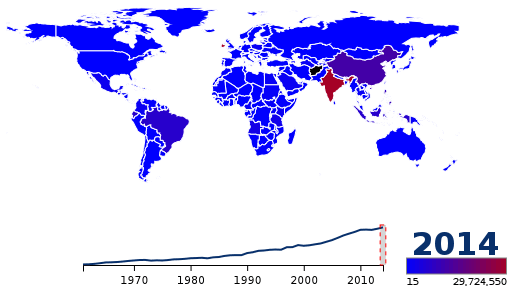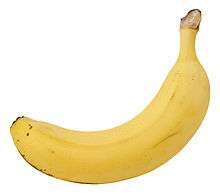Banana
A banana is an elongated, edible fruit – botanically a berry[1][2] – produced by several kinds of large herbaceous flowering plants in the genus Musa.[3] In some countries, bananas used for cooking may be called "plantains", distinguishing them from dessert bananas. The fruit is variable in size, color, and firmness, but is usually elongated and curved, with soft flesh rich in starch covered with a rind, which may be green, yellow, red, purple, or brown when ripe. The fruits grow in clusters hanging from the top of the plant. Almost all modern edible seedless (parthenocarp) bananas come from two wild species – Musa acuminata and Musa balbisiana. The scientific names of most cultivated bananas are Musa acuminata, Musa balbisiana, and Musa × paradisiaca for the hybrid Musa acuminata × M. balbisiana, depending on their genomic constitution. The old scientific name for this hybrid, Musa sapientum, is no longer used.
| Banana | |
|---|---|
 | |
| Peeled, whole, and longitudinal section | |
| Scientific classification | |
| Kingdom: | |
| (unranked): | |
| (unranked): | |
| (unranked): | |
| Order: | |
| Family: | |
| Genus: | |

Musa species are native to tropical Indomalaya and Australia, and are likely to have been first domesticated in Papua New Guinea.[4][5] They are grown in 135 countries,[6] primarily for their fruit, and to a lesser extent to make fiber, banana wine, and banana beer and as ornamental plants. The world's largest producers of bananas in 2017 were India and China, which together accounted for approximately 38% of total production.[7]
Worldwide, there is no sharp distinction between "bananas" and "plantains". Especially in the Americas and Europe, "banana" usually refers to soft, sweet, dessert bananas, particularly those of the Cavendish group, which are the main exports from banana-growing countries. By contrast, Musa cultivars with firmer, starchier fruit are called "plantains". In other regions, such as Southeast Asia, many more kinds of banana are grown and eaten, so the binary distinction is not useful and is not made in local languages.
The term "banana" is also used as the common name for the plants that produce the fruit.[3] This can extend to other members of the genus Musa, such as the scarlet banana (Musa coccinea), the pink banana (Musa velutina), and the Fe'i bananas. It can also refer to members of the genus Ensete, such as the snow banana (Ensete glaucum) and the economically important false banana (Ensete ventricosum). Both genera are in the banana family, Musaceae.
Description
 A banana corm, about 25 cm (10 in) across
A banana corm, about 25 cm (10 in) across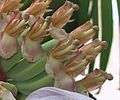 Female flowers have petals at the tip of the ovary
Female flowers have petals at the tip of the ovary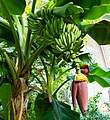 Banana 'tree' showing fruit and inflorescence
Banana 'tree' showing fruit and inflorescence Banana tree with opening inflorescence
Banana tree with opening inflorescence- Banana inflorescence, partially opened
 Wild banana with flowers and stem growing in reverse direction
Wild banana with flowers and stem growing in reverse direction Extracted banana's DNA strands that can be seen with naked eyes
Extracted banana's DNA strands that can be seen with naked eyes
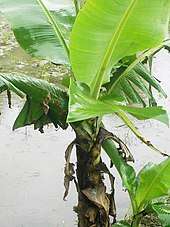
The banana plant is the largest herbaceous flowering plant.[8] All the above-ground parts of a banana plant grow from a structure usually called a "corm".[9] Plants are normally tall and fairly sturdy, and are often mistaken for trees, but what appears to be a trunk is actually a "false stem" or pseudostem. Bananas grow in a wide variety of soils, as long as the soil is at least 60 centimetres (2.0 ft) deep, has good drainage and is not compacted.[10] The leaves of banana plants are composed of a "stalk" (petiole) and a blade (lamina). The base of the petiole widens to form a sheath; the tightly packed sheaths make up the pseudostem, which is all that supports the plant. The edges of the sheath meet when it is first produced, making it tubular. As new growth occurs in the centre of the pseudostem the edges are forced apart.[11] Cultivated banana plants vary in height depending on the variety and growing conditions. Most are around 5 m (16 ft) tall, with a range from 'Dwarf Cavendish' plants at around 3 m (10 ft) to 'Gros Michel' at 7 m (23 ft) or more.[12][13] Leaves are spirally arranged and may grow 2.7 metres (8.9 ft) long and 60 cm (2.0 ft) wide.[1] They are easily torn by the wind, resulting in the familiar frond look.[14]
When a banana plant is mature, the corm stops producing new leaves and begins to form a flower spike or inflorescence. A stem develops which grows up inside the pseudostem, carrying the immature inflorescence until eventually it emerges at the top.[15] Each pseudostem normally produces a single inflorescence, also known as the "banana heart". (More are sometimes produced; an exceptional plant in the Philippines produced five.[16]) After fruiting, the pseudostem dies, but offshoots will normally have developed from the base, so that the plant as a whole is perennial. In the plantation system of cultivation, only one of the offshoots will be allowed to develop in order to maintain spacing.[17] The inflorescence contains many bracts (sometimes incorrectly referred to as petals) between rows of flowers. The female flowers (which can develop into fruit) appear in rows further up the stem (closer to the leaves) from the rows of male flowers. The ovary is inferior, meaning that the tiny petals and other flower parts appear at the tip of the ovary.[18]
The banana fruits develop from the banana heart, in a large hanging cluster, made up of tiers (called "hands"), with up to 20 fruit to a tier. The hanging cluster is known as a bunch, comprising 3–20 tiers, or commercially as a "banana stem", and can weigh 30–50 kilograms (66–110 lb). Individual banana fruits (commonly known as a banana or "finger") average 125 grams (4 1⁄2 oz), of which approximately 75% is water and 25% dry matter (nutrient table, lower right).
The fruit has been described as a "leathery berry".[19] There is a protective outer layer (a peel or skin) with numerous long, thin strings (the phloem bundles), which run lengthwise between the skin and the edible inner portion. The inner part of the common yellow dessert variety can be split lengthwise into three sections that correspond to the inner portions of the three carpels by manually deforming the unopened fruit.[20] In cultivated varieties, the seeds are diminished nearly to non-existence; their remnants are tiny black specks in the interior of the fruit.[21]
Banana equivalent radiation dose
As with all potassium-containing objects on Earth, including many common foods and people, bananas emit radioactivity at very low levels occurring naturally from potassium-40 (40K or K-40),[22] which is one of several isotopes of potassium.[23][24] The banana equivalent dose of radiation was developed in 1995 as a simple teaching-tool to educate the public about the natural, small amount of K-40 radiation occurring in every human and in common foods – where the banana was used as an example.[25][26] The K-40 in a banana contains about 15 becquerels or 0.1 micro-sieverts (units of radioactivity exposure),[27] an amount that does not add to the total body radiation dose when a banana is consumed.[22][26] The radiation exposure from consuming one banana is approximately 1% of the average daily exposure to radiation, or about 50 times less than a typical x-ray in a dental exam and 400 times less than taking a commercial flight across the United States.[27]
Etymology
The word banana is thought to be of West African origin, possibly from the Wolof word banaana, and passed into English via Spanish or Portuguese.[28]
Taxonomy

.jpg)
The genus Musa was created by Carl Linnaeus in 1753.[29] The name may be derived from Antonius Musa, physician to the Emperor Augustus, or Linnaeus may have adapted the Arabic word for banana, mauz.[30] The old biological name Musa sapientum = "Muse of the wise" arose because of homophony in Latin with the classical Muses.
Musa is in the family Musaceae. The APG III system assigns Musaceae to the order Zingiberales, part of the commelinid clade of the monocotyledonous flowering plants. Some 70 species of Musa were recognized by the World Checklist of Selected Plant Families as of January 2013;[29] several produce edible fruit, while others are cultivated as ornamentals.[31]
The classification of cultivated bananas has long been a problematic issue for taxonomists. Linnaeus originally placed bananas into two species based only on their uses as food: Musa sapientum for dessert bananas and Musa paradisiaca for plantains. More species names were added, but this approach proved to be inadequate for the number of cultivars in the primary center of diversity of the genus, Southeast Asia. Many of these cultivars were given names that were later discovered to be synonyms.[32]
In a series of papers published from 1947 onwards, Ernest Cheesman showed that Linnaeus's Musa sapientum and Musa paradisiaca were cultivars and descendants of two wild seed-producing species, Musa acuminata and Musa balbisiana, both first described by Luigi Aloysius Colla.[33] Cheesman recommended the abolition of Linnaeus's species in favor of reclassifying bananas according to three morphologically distinct groups of cultivars – those primarily exhibiting the botanical characteristics of Musa balbisiana, those primarily exhibiting the botanical characteristics of Musa acuminata, and those with characteristics of both.[32] Researchers Norman Simmonds and Ken Shepherd proposed a genome-based nomenclature system in 1955. This system eliminated almost all the difficulties and inconsistencies of the earlier classification of bananas based on assigning scientific names to cultivated varieties. Despite this, the original names are still recognized by some authorities, leading to confusion.[33][34]
The accepted scientific names for most groups of cultivated bananas are Musa acuminata Colla and Musa balbisiana Colla for the ancestral species, and Musa × paradisiaca L. for the hybrid M. acuminata × M. balbisiana.[35]
Synonyms of M. × paradisiaca include
- many subspecific and varietal names of M. × paradisiaca, including M. p. subsp. sapientum (L.) Kuntze
- Musa × dacca Horan.
- Musa × sapidisiaca K.C.Jacob, nom. superfl.
- Musa × sapientum L., and many of its varietal names, including M. × sapientum var. paradisiaca (L.) Baker, nom. illeg.
Generally, modern classifications of banana cultivars follow Simmonds and Shepherd's system. Cultivars are placed in groups based on the number of chromosomes they have and which species they are derived from. Thus the Latundan banana is placed in the AAB Group, showing that it is a triploid derived from both M. acuminata (A) and M. balbisiana (B). For a list of the cultivars classified under this system, see "List of banana cultivars".
In 2012, a team of scientists announced they had achieved a draft sequence of the genome of Musa acuminata.[36]
Bananas and plantains
In regions such as North America and Europe, Musa fruits offered for sale can be divided into "bananas" and "plantains", based on their intended use as food. Thus the banana producer and distributor Chiquita produces publicity material for the American market which says that "a plantain is not a banana". The stated differences are that plantains are more starchy and less sweet; they are eaten cooked rather than raw; they have thicker skin, which may be green, yellow or black; and they can be used at any stage of ripeness.[37] Linnaeus made the same distinction between plantains and bananas when first naming two "species" of Musa.[38] Members of the "plantain subgroup" of banana cultivars, most important as food in West Africa and Latin America, correspond to the Chiquita description, having long pointed fruit. They are described by Ploetz et al. as "true" plantains, distinct from other cooking bananas.[39] The cooking bananas of East Africa belong to a different group, the East African Highland bananas,[13] so would not qualify as "true" plantains on this definition.

An alternative approach divides bananas into dessert bananas and cooking bananas, with plantains being one of the subgroups of cooking bananas.[40] Triploid cultivars derived solely from M. acuminata are examples of "dessert bananas", whereas triploid cultivars derived from the hybrid between M. acuminata and M. balbinosa (in particular the plantain subgroup of the AAB Group) are "plantains".[41][42] Small farmers in Colombia grow a much wider range of cultivars than large commercial plantations. A study of these cultivars showed that they could be placed into at least three groups based on their characteristics: dessert bananas, non-plantain cooking bananas, and plantains, although there were overlaps between dessert and cooking bananas.[43]
In Southeast Asia – the center of diversity for bananas, both wild and cultivated – the distinction between "bananas" and "plantains" does not work, according to Valmayor et al. Many bananas are used both raw and cooked. There are starchy cooking bananas which are smaller than those eaten raw. The range of colors, sizes and shapes is far wider than in those grown or sold in Africa, Europe or the Americas.[38] Southeast Asian languages do not make the distinction between "bananas" and "plantains" that is made in English (and Spanish). Thus both Cavendish cultivars, the classic yellow dessert bananas, and Saba cultivars, used mainly for cooking, are called pisang in Malaysia and Indonesia, kluai in Thailand and chuoi in Vietnam.[44] Fe'i bananas, grown and eaten in the islands of the Pacific, are derived from entirely different wild species than traditional bananas and plantains. Most Fe'i bananas are cooked, but Karat bananas, which are short and squat with bright red skins, very different from the usual yellow dessert bananas, are eaten raw.[45]
In summary, in commerce in Europe and the Americas (although not in small-scale cultivation), it is possible to distinguish between "bananas", which are eaten raw, and "plantains", which are cooked. In other regions of the world, particularly India, Southeast Asia and the islands of the Pacific, there are many more kinds of banana and the two-fold distinction is not useful and not made in local languages. Plantains are one of many kinds of cooking bananas, which are not always distinct from dessert bananas.
Historical cultivation
Early cultivation
_original_range.png)
The earliest domestication of bananas (Musa spp.) were initially from naturally occurring parthenocarpic (seedless) individuals of Musa acuminata banksii in New Guinea. These were cultivated by Papuans before the arrival of Austronesian-speakers. Numerous phytoliths of bananas have been recovered from the Kuk Swamp archaeological site and dated to around 10,000 to 6,500 BP. From New Guinea, cultivated bananas spread westward into Island Southeast Asia through proximity (not migrations). They hybridized with other (possibly independently domesticated) subspecies of Musa acuminata as well as Musa balbisiana in the Philippines, northern New Guinea, and possibly Halmahera. These hybridization events produced the triploid cultivars of bananas commonly grown today. From Island Southeast Asia, they became part of the staple crops of Austronesian peoples and were spread during their voyages and ancient maritime trading routes into Oceania, East Africa, South Asia, and Indochina.[47][48][49]
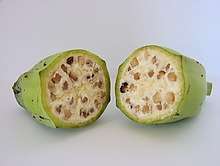
.png)
These ancient introductions resulted in the banana subgroup now known as the "true" plantains, which include the East African Highland bananas and the Pacific plantains (the Iholena and Maoli-Popo'ulu subgroups). East African Highland bananas originated from banana populations introduced to Madagascar probably from the region between Java, Borneo, and New Guinea; while Pacific plantains were introduced to the Pacific Islands from either eastern New Guinea or the Bismarck Archipelago.[47][48]
Phytolith discoveries in Cameroon dating to the first millennium BCE[51] triggered an as yet unresolved debate about the date of first cultivation in Africa. There is linguistic evidence that bananas were known in Madagascar around that time.[52] The earliest prior evidence indicates that cultivation dates to no earlier than late 6th century CE.[53] It is likely, however, that bananas were brought at least to Madagascar if not to the East African coast during the phase of Malagasy colonization of the island from South East Asia c. 400 CE.[54]
A second wave of introductions later spread bananas to other parts of tropical Asia, particularly Indochina and the Indian Subcontinent.[47][48] However, there is evidence that bananas were known to the Indus Valley Civilisation from phytoliths recovered from the Kot Diji archaeological site in Pakistan (although they are absent in other contemporary sites in South Asia). This may be a possible indication of very early dispersal of bananas by Austronesian traders by sea from as early as 2000 BCE. But this is still putative, as they may have come from local wild Musa species used for fiber or as ornamentals, not food.[49]
Southeast Asia remains the region of primary diversity of the banana. Areas of secondary diversity are found in Africa, indicating a long history of banana cultivation in these regions.[55]
The banana may also have been present in isolated locations elsewhere in the Middle East on the eve of Islam. The spread of Islam was followed by far-reaching diffusion. There are numerous references to it in Islamic texts (such as poems and hadiths) beginning in the 9th century. By the 10th century the banana appears in texts from Palestine and Egypt. From there it diffused into North Africa and Muslim Iberia. During the medieval ages, bananas from Granada were considered among the best in the Arab world.[56] In 650, Islamic conquerors brought the banana to Palestine. Today, banana consumption increases significantly in Islamic countries during Ramadan, the month of daylight fasting.[57]
Bananas were certainly grown in the Christian Kingdom of Cyprus by the late medieval period. Writing in 1458, the Italian traveller and writer Gabriele Capodilista wrote favourably of the extensive farm produce of the estates at Episkopi, near modern-day Limassol, including the region's banana plantations.[58]
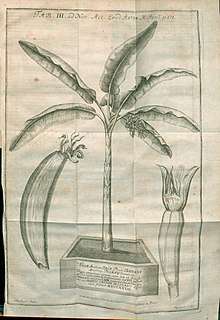
Bananas were introduced to the Americas by Portuguese sailors who brought the fruits from West Africa in the 16th century.[59]
Many wild banana species as well as cultivars exist in extraordinary diversity in India, China, and Southeast Asia.
There are fuzzy bananas whose skins are bubblegum pink; green-and-white striped bananas with pulp the color of orange sherbet; bananas that, when cooked, taste like strawberries. The Double Mahoi plant can produce two bunches at once. The Chinese name of the aromatic Go San Heong banana means 'You can smell it from the next mountain.' The fingers on one banana plant grow fused; another produces bunches of a thousand fingers, each only an inch long.
— Mike Peed, The New Yorker[60]
Plantation cultivation in the Caribbean, Central and South America
In the 15th and 16th centuries, Portuguese colonists started banana plantations in the Atlantic Islands, Brazil, and western Africa.[61] North Americans began consuming bananas on a small scale at very high prices shortly after the Civil War, though it was only in the 1880s that the food became more widespread.[62] As late as the Victorian Era, bananas were not widely known in Europe, although they were available.[61] Jules Verne introduces bananas to his readers with detailed descriptions in Around the World in Eighty Days (1872).
The earliest modern plantations originated in Jamaica and the related Western Caribbean Zone, including most of Central America. It involved the combination of modern transportation networks of steamships and railroads with the development of refrigeration that allowed more time between harvesting and ripening. North American shippers like Lorenzo Dow Baker and Andrew Preston, the founders of the Boston Fruit Company started this process in the 1870s, but railroad builders like Minor C. Keith also participated, eventually culminating in the multi-national giant corporations like today's Chiquita Brands International and Dole.[62] These companies were monopolistic, vertically integrated (meaning they controlled growing, processing, shipping and marketing) and usually used political manipulation to build enclave economies (economies that were internally self-sufficient, virtually tax exempt, and export-oriented that contribute very little to the host economy). Their political maneuvers, which gave rise to the term Banana republic for states like Honduras and Guatemala, included working with local elites and their rivalries to influence politics or playing the international interests of the United States, especially during the Cold War, to keep the political climate favorable to their interests.[63]
Peasant cultivation for export in the Caribbean
The vast majority of the world's bananas today are cultivated for family consumption or for sale on local markets. India is the world leader in this sort of production, but many other Asian and African countries where climate and soil conditions allow cultivation also host large populations of banana growers who sell at least some of their crop.[64]
Peasant sector banana growers produce for the world market in the Caribbean, however. The Windward Islands are notable for the growing, largely of Cavendish bananas, for an international market, generally in Europe but also in North America. In the Caribbean, and especially in Dominica where this sort of cultivation is widespread, holdings are in the 1–2 acre range. In many cases the farmer earns additional money from other crops, from engaging in labor outside the farm, and from a share of the earnings of relatives living overseas.[65]
Banana crops are vulnerable to destruction by high winds, such as tropical storms or cyclones.[66]
Modern cultivation
All widely cultivated bananas today descend from the two wild bananas Musa acuminata and Musa balbisiana. While the original wild bananas contained large seeds, diploid or polyploid cultivars (some being hybrids) with tiny seeds are preferred for human raw fruit consumption.[67] These are propagated asexually from offshoots. The plant is allowed to produce two shoots at a time; a larger one for immediate fruiting and a smaller "sucker" or "follower" to produce fruit in 6–8 months.
As a non-seasonal crop, bananas are available fresh year-round.[68]
Cavendish

In global commerce in 2009, by far the most important cultivars belonged to the triploid AAA group of Musa acuminata, commonly referred to as Cavendish group bananas. They accounted for the majority of banana exports,[67] despite only coming into existence in 1836.[69] The cultivars Dwarf Cavendish and Grand Nain (Chiquita Banana) gained popularity in the 1950s after the previous mass-produced cultivar, Gros Michel (also an AAA group cultivar), became commercially unviable due to Panama disease, caused by the fungus Fusarium oxysporum which attacks the roots of the banana plant.[67] Cavendish cultivars are resistant to the Panama disease, but in 2013 there were fears that the black sigatoka fungus would in turn make Cavendish bananas unviable.[70]
Even though it is no longer viable for large scale cultivation, Gros Michel is not extinct and is still grown in areas where Panama disease is not found.[71] Likewise, Dwarf Cavendish and Grand Nain are in no danger of extinction, but they may leave supermarket shelves if disease makes it impossible to supply the global market. It is unclear if any existing cultivar can replace Cavendish bananas, so various hybridisation and genetic engineering programs are attempting to create a disease-resistant, mass-market banana.[67] One such strain that has emerged is the Taiwanese Cavendish, also known as the Formosana.[72]
Ripening
Export bananas are picked green, and ripen in special rooms upon arrival in the destination country. These rooms are air-tight and filled with ethylene gas to induce ripening. The vivid yellow color consumers normally associate with supermarket bananas is, in fact, caused by the artificial ripening process.[73] Flavor and texture are also affected by ripening temperature. Bananas are refrigerated to between 13.5 and 15 °C (56.3 and 59.0 °F) during transport. At lower temperatures, ripening permanently stalls, and the bananas turn gray as cell walls break down. The skin of ripe bananas quickly blackens in the 4 °C (39 °F) environment of a domestic refrigerator, although the fruit inside remains unaffected.

Bananas can be ordered by the retailer "ungassed" (i.e. not treated with ethylene), and may show up at the supermarket fully green. Guineos verdes (green bananas) that have not been gassed will never fully ripen before becoming rotten. Instead of fresh eating, these bananas can be used for cooking, as seen in Jamaican cuisine.[74]
A 2008 study reported that ripe bananas fluoresce when exposed to ultraviolet light. This property is attributed to the degradation of chlorophyll leading to the accumulation of a fluorescent product in the skin of the fruit. The chlorophyll breakdown product is stabilized by a propionate ester group. Banana-plant leaves also fluoresce in the same way. Green (under-ripe) bananas do not fluoresce.[75] That paper suggested that this fluorescence could be put to use "for optical in vivo monitoring of ripening and over-ripening of bananas and other fruit."
Storage and transport
Bananas must be transported over long distances from the tropics to world markets.[76] To obtain maximum shelf life, harvest comes before the fruit is mature. The fruit requires careful handling, rapid transport to ports, cooling, and refrigerated shipping. The goal is to prevent the bananas from producing their natural ripening agent, ethylene. This technology allows storage and transport for 3–4 weeks at 13 °C (55 °F). On arrival, bananas are held at about 17 °C (63 °F) and treated with a low concentration of ethylene. After a few days, the fruit begins to ripen and is distributed for final sale. Ripe bananas can be held for a few days at home. If bananas are too green, they can be put in a brown paper bag with an apple or tomato overnight to speed up the ripening process.[77]
Carbon dioxide (which bananas produce) and ethylene absorbents extend fruit life even at high temperatures. This effect can be exploited by packing banana in a polyethylene bag and including an ethylene absorbent, e.g., potassium permanganate, on an inert carrier. The bag is then sealed with a band or string. This treatment has been shown to more than double lifespans up to 3–4 weeks without the need for refrigeration.[78][79][80]
Sustainability
The excessive use of fertilizers often left in abandoned plantations contributes greatly to eutrophication in local streams and lakes, and harms aquatic life after algal blooms deprive fish of oxygen. It has been theorized that destruction of 60% of coral reefs along the coasts of Costa Rica is partially from sediments from banana plantations. Another issue is the deforestation associated with expanding banana production. As monocultures rapidly deplete soil nutrients plantations expand to areas with rich soils and cut down forests, which also affects soil erosion and degradation, and increases frequency of flooding. The World Wildlife Fund (WWF) stated that banana production produced more waste than any other agricultural sector, mostly from discarded banana plants, bags used to cover the bananas, strings to tie them, and containers for transport.[81]
Production and export
| Bananas | Plantains | Total | |
|---|---|---|---|
| 30.5 | 30.5 | ||
| 11.2 | 11.2 | ||
| 6.1 | 3.1 | 9.2 | |
| 3.8 | 3.6 | 7.4 | |
| 7.2 | 7.2 | ||
| 6.3 | 0.8 | 7.1 | |
| 6.7 | 6.7 | ||
| 1.3 | 4.5 | 5.8 | |
| 0.3 | 4.8 | 5.1 | |
| 4.3 | 4.3 | ||
| 3.9 | 0.4 | 4.3 | |
| 0.1 | 4.1 | 4.2 | |
| 3.5 | 0.6 | 4.1 | |
| 0.6 | 3.3 | 3.9 | |
| 3.2 | 3.2 | ||
| 2.6 | 0.1 | 2.7 | |
| 0.3 | 2.0 | 2.3 | |
| 2.2 | 2.2 | ||
| 1.2 | 1.0 | 2.2 | |
| 2.1 | 2.1 | ||
| World | 113.9 | 39.2 | 153.1 |
| Source: FAOSTAT of the United Nations[83][84] Note: Some countries distinguish between bananas and plantains, but four of the top six producers do not, thus necessitating comparisons using the total for bananas and plantains combined. | |||
In 2017, world production of bananas and plantains combined was 153 million tonnes, led by India and China with a combined total of 27% of global production[85][86]. Other major producers were the Philippines, Colombia, Indonesia, Ecuador, and Brazil.
As reported for 2013, total world exports were 20 million tonnes of bananas and 859,000 tonnes of plantains.[87] Ecuador and the Philippines were the leading exporters with 5.4 and 3.3 million tonnes, respectively, and the Dominican Republic was the leading exporter of plantains with 210,350 tonnes.[87]
Developing countries
Bananas and plantains constitute a major staple food crop for millions of people in developing countries. In many tropical countries, green (unripe) bananas used for cooking represent the main cultivars. Most producers are small-scale farmers either for home consumption or local markets. Because bananas and plantains produce fruit year-round, they provide a valuable food source during the hunger season (when the food from one annual/semi-annual harvest has been consumed, and the next is still to come). Bananas and plantains are important for global food security.[88]
Pests, diseases, and natural disasters
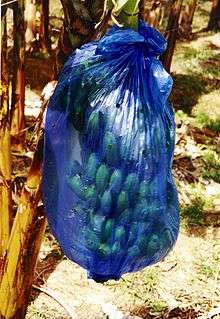
While in no danger of outright extinction, the most common edible banana cultivar Cavendish (extremely popular in Europe and the Americas) could become unviable for large-scale cultivation in the next 10–20 years. Its predecessor 'Gros Michel', discovered in the 1820s, suffered this fate. Like almost all bananas, Cavendish lacks genetic diversity, which makes it vulnerable to diseases, threatening both commercial cultivation and small-scale subsistence farming.[89][90] Some commentators remarked that those variants which could replace what much of the world considers a "typical banana" are so different that most people would not consider them the same fruit, and blame the decline of the banana on monogenetic cultivation driven by short-term commercial motives.[63]
Panama disease
Panama disease is caused by a fusarium soil fungus (Race 1), which enters the plants through the roots and travels with water into the trunk and leaves, producing gels and gums that cut off the flow of water and nutrients, causing the plant to wilt, and exposing the rest of the plant to lethal amounts of sunlight. Prior to 1960, almost all commercial banana production centered on "Gros Michel", which was highly susceptible.[91] Cavendish was chosen as the replacement for Gros Michel because, among resistant cultivars, it produces the highest quality fruit. However, more care is required for shipping the Cavendish,[92] and its quality compared to Gros Michel is debated.[93]
According to current sources, a deadly form of Panama disease is infecting Cavendish. All plants are genetically identical, which prevents evolution of disease resistance. Researchers are examining hundreds of wild varieties for resistance.[91]
Tropical race 4
Tropical race 4 (TR4), a reinvigorated strain of Panama disease, was first discovered in 1993. This virulent form of fusarium wilt destroyed Cavendish in several southeast Asian countries and spread to Australia and India.[94] As the soil-based fungi can easily be carried on boots, clothing, or tools, the wilt spread to the Americas despite years of preventive efforts.[94] Cavendish is highly susceptible to TR4, and over time, Cavendish is endangered for commercial production by this disease.[95] The only known defense to TR4 is genetic resistance.[94] This is conferred either by RGA2, a gene isolated from a TR4-resistant diploid banana, or by the nematode-derived Ced9.[96] Experts state the need to enrich banana biodiversity by producing diverse new banana varieties, not just having a focus on the Cavendish.[94]
Black sigatoka
Black sigatoka is a fungal leaf spot disease first observed in Fiji in 1963 or 1964. Black Sigatoka (also known as black leaf streak) has spread to banana plantations throughout the tropics from infected banana leaves that were used as packing material. It affects all main cultivars of bananas and plantains (including the Cavendish cultivars[70]), impeding photosynthesis by blackening parts of the leaves, eventually killing the entire leaf. Starved for energy, fruit production falls by 50% or more, and the bananas that do grow ripen prematurely, making them unsuitable for export. The fungus has shown ever-increasing resistance to treatment, with the current expense for treating 1 hectare (2.5 acres) exceeding $1,000 per year. In addition to the expense, there is the question of how long intensive spraying can be environmentally justified.
Banana bunchy top virus
Banana bunchy top virus (BBTV) is a plant virus of the genus Babuvirus, family Nanonviridae affecting Musa spp. (including banana, abaca, plantain and ornamental bananas) and Ensete spp. in the family Musaceae.[97] Banana bunchy top disease (BBTD) symptoms include dark green streaks of variable length in leaf veins, midribs and petioles. Leaves become short and stunted as the disease progresses, becoming 'bunched' at the apex of the plant. Infected plants may produce no fruit or the bunch may not emerge from the pseudostem.[98] The virus is transmitted by the banana aphid Pentalonia nigronervosa and is widespread in SE Asia, Asia, the Philippines, Taiwan, Oceania and parts of Africa. There is no cure for BBTD, but it can be effectively controlled by the eradication of diseased plants and the use of virus-free planting material.[99] No resistant cultivars have been found, but varietal differences in susceptibility have been reported. The commercially important Cavendish subgroup is severely affected.[98]
Banana bacterial wilt
Banana bacterial wilt (BBW) is a bacterial disease caused by Xanthomonas campestris pv. musacearum.[100] After being originally identified on a close relative of bananas, Ensete ventricosum, in Ethiopia in the 1960s,[101] BBW occurred in Uganda in 2001 affecting all banana cultivars. Since then BBW has been diagnosed in Central and East Africa including the banana growing regions of Rwanda, the Democratic Republic of the Congo, Tanzania, Kenya, Burundi, and Uganda.[102]
Conservation
Given the narrow range of genetic diversity present in bananas and the many threats via biotic (pests and diseases) and abiotic (such as drought) stress, conservation of the full spectrum of banana genetic resources is ongoing.[103] Banana germplasm is conserved in many national and regional gene banks, and at the world's largest banana collection, the International Musa Germplasm Transit Centre (ITC), managed by Bioversity International and hosted at KU Leuven in Belgium.[104] Musa cultivars are usually seedless, and options for their long-term conservation are constrained by the vegetative nature of the plant's reproductive system. Consequently, they are conserved by three main methods: in vivo (planted in field collections), in vitro (as plantlets in test tubes within a controlled environment), and by cryopreservation (meristems conserved in liquid nitrogen at −196 °C).[103] Genes from wild banana species are conserved as DNA and as cryopreserved pollen[103] and banana seeds from wild species are also conserved, although less commonly, as they are difficult to regenerate. In addition, bananas and their crop wild relatives are conserved in situ (in wild natural habitats where they evolved and continue to do so). Diversity is also conserved in farmers' fields where continuous cultivation, adaptation and improvement of cultivars is often carried out by small-scale farmers growing traditional local cultivars.[105]

Nutrition
| Nutritional value per 100 g (3.5 oz) | |
|---|---|
| Energy | 371 kJ (89 kcal) |
22.84 g | |
| Sugars | 12.23 g |
| Dietary fiber | 2.6 g |
0.33 g | |
1.09 g | |
| Vitamins | Quantity %DV† |
| Thiamine (B1) | 3% 0.031 mg |
| Riboflavin (B2) | 6% 0.073 mg |
| Niacin (B3) | 4% 0.665 mg |
| Pantothenic acid (B5) | 7% 0.334 mg |
| Vitamin B6 | 31% 0.4 mg |
| Folate (B9) | 5% 20 μg |
| Choline | 2% 9.8 mg |
| Vitamin C | 10% 8.7 mg |
| Minerals | Quantity %DV† |
| Iron | 2% 0.26 mg |
| Magnesium | 8% 27 mg |
| Manganese | 13% 0.27 mg |
| Phosphorus | 3% 22 mg |
| Potassium | 8% 358 mg |
| Sodium | 0% 1 mg |
| Zinc | 2% 0.15 mg |
| Other constituents | Quantity |
| Water | 74.91 g |
Link to USDA Database entry
values are for edible portion | |
| |
| †Percentages are roughly approximated using US recommendations for adults. Source: USDA Nutrient Database | |
Raw bananas (not including the peel) are 75% water, 23% carbohydrates, 1% protein, and contain negligible fat. A 100-gram reference serving supplies 89 Calories, 31% of the US recommended Daily Value (DV) of vitamin B6, and moderate amounts of vitamin C, manganese and dietary fiber, with no other micronutrients in significant content (see table).
Potassium
Although bananas are commonly thought to contain exceptional potassium content,[26][106] their actual potassium content is not high per typical food serving, having only 8% of the US recommended Daily Value for potassium (considered a low level of the DV, see nutrition table), and their potassium-content ranking among fruits, vegetables, legumes, and many other foods is relatively moderate.[107][108] Vegetables with higher potassium content than raw dessert bananas (358 mg per 100 gm) include raw spinach (558 mg per 100 gm), baked potatoes without skin (391 mg per 100 gm), cooked soybeans (539 mg per 100 gm), grilled portabella mushrooms (437 mg per 100 gm), and processed tomato sauces (413–439 mg per 100 gm). Raw plantains contain 499 mg potassium per 100 gm. Dehydrated dessert bananas or banana powder contain 1491 mg potassium per 100 gm.[107]
Allergen
Individuals with a latex allergy may experience a reaction to bananas.[109]
Culture
Food and cooking
Fruit
Bananas are a staple starch for many tropical populations. Depending upon cultivar and ripeness, the flesh can vary in taste from starchy to sweet, and texture from firm to mushy. Both the skin and inner part can be eaten raw or cooked. The primary component of the aroma of fresh bananas is isoamyl acetate (also known as banana oil), which, along with several other compounds such as butyl acetate and isobutyl acetate, is a significant contributor to banana flavor.[110][111][112]
During the ripening process, bananas produce the gas ethylene, which acts as a plant hormone and indirectly affects the flavor. Among other things, ethylene stimulates the formation of amylase, an enzyme that breaks down starch into sugar, influencing the taste of bananas. The greener, less ripe bananas contain higher levels of starch and, consequently, have a "starchier" taste. On the other hand, yellow bananas taste sweeter due to higher sugar concentrations. Furthermore, ethylene signals the production of pectinase, an enzyme which breaks down the pectin between the cells of the banana, causing the banana to soften as it ripens.[113][114]
Bananas are eaten deep fried, baked in their skin in a split bamboo, or steamed in glutinous rice wrapped in a banana leaf. Bananas can be made into fruit preserves. Banana pancakes are popular among travelers in South Asia and Southeast Asia. This has elicited the expression Banana Pancake Trail for those places in Asia that cater to these travelers. Banana chips are a snack produced from sliced dehydrated or fried banana or plantain, which have a dark brown color and an intense banana taste. Dried bananas are also ground to make banana flour. Extracting juice is difficult, because when a banana is compressed, it simply turns to pulp. Bananas feature prominently in Philippine cuisine, being part of traditional dishes and desserts like maruya, turón, and halo-halo or saba con yelo. Most of these dishes use the Saba Banana or Cardaba banana cultivar. Bananas are also commonly used in cuisine in the South-Indian state of Kerala, where they are steamed (puzhungiyathu), made into curries,[115] fried into chips, (upperi)[116] or fried in batter (pazhampori).[117] Pisang goreng, bananas fried with batter similar to the Filipino maruya or Kerala pazhampori, is a popular dessert in Malaysia, Singapore, and Indonesia. A similar dish is known in the United Kingdom and United States as banana fritters.
Plantains are used in various stews and curries or cooked, baked or mashed in much the same way as potatoes, such as the pazham pachadi dish prepared in Kerala.[115]
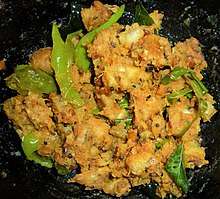
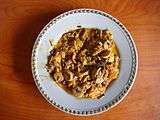
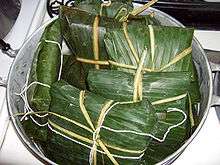


Flower
Banana hearts are used as a vegetable[118] in South Asian and Southeast Asian cuisine, either raw or steamed with dips or cooked in soups, curries and fried foods.[119][120] The flavor resembles that of artichoke. As with artichokes, both the fleshy part of the bracts and the heart are edible.[121]
Leaves
Banana leaves are large, flexible, and waterproof. They are often used as ecologically friendly disposable food containers or as "plates" in South Asia and several Southeast Asian countries.[122] In Indonesian cuisine, banana leaf is employed in cooking methods like pepes and botok; banana leaf packages containing food ingredients and spices are cooked in steam or in boiled water, or are grilled on charcoal. When used so for steaming or grilling, the banana leaves protect the food ingredients from burning and add a subtle sweet flavor.[123] In South India, it is customary to serve traditional food on a banana leaf. In Tamil Nadu (India), dried banana leaves are used as to pack food and to make cups to hold liquid food items.
Trunk
The tender core of the banana plant's trunk is also used in South Asian and Southeast Asian cuisine. Examples include the Burmese dish mohinga, and the Filipino dish inubaran.[124]
Fiber
Textiles
Banana fiber harvested from the pseudostems and leaves of the plant has been used for textiles in Asia since at least the 13th century. Both fruit-bearing and fibrous varieties of the banana plant have been used.[125] In the Japanese system Kijōka-bashōfu, leaves and shoots are cut from the plant periodically to ensure softness. Harvested shoots are first boiled in lye to prepare fibers for yarn-making. These banana shoots produce fibers of varying degrees of softness, yielding yarns and textiles with differing qualities for specific uses. For example, the outermost fibers of the shoots are the coarsest, and are suitable for tablecloths, while the softest innermost fibers are desirable for kimono and kamishimo. This traditional Japanese cloth-making process requires many steps, all performed by hand.[126]
In India, a banana fiber separator machine has been developed, which takes the agricultural waste of local banana harvests and extracts strands of the fiber.[127]
Paper
Banana fiber is used in the production of banana paper. Banana paper is made from two different parts: the bark of the banana plant, mainly used for artistic purposes, or from the fibers of the stem and non-usable fruits. The paper is either hand-made or by industrial process.[128]
Cultural roles
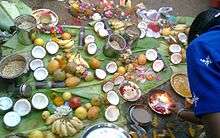

Arts
- The song "Yes! We Have No Bananas" was written by Frank Silver and Irving Cohn and originally released in 1923; for many decades, it was the best-selling sheet music in history. Since then the song has been rerecorded several times and has been particularly popular during banana shortages.[129][130]
- A person slipping on a banana peel has been a staple of physical comedy for generations. An American comedy recording from 1910 features a popular character of the time, "Uncle Josh", claiming to describe his own such incident:[131]
Now I don't think much of the man that throws a banana peelin' on the sidewalk, and I don't think much of the banana peel that throws a man on the sidewalk neither ... my foot hit the bananer peelin' and I went up in the air, and I come down ker-plunk, jist as I was pickin' myself up a little boy come runnin' across the street ... he says, "Oh mister, won't you please do that agin? My little brother didn't see you do it."
- The poet Bashō is named after the Japanese word for a banana plant. The "bashō" planted in his garden by a grateful student became a source of inspiration to his poetry, as well as a symbol of his life and home.[132]
- The cover artwork for the debut album of The Velvet Underground features a banana made by Andy Warhol. On the original vinyl LP version, the design allowed the listener to "peel" this banana to find a pink, peeled phallic banana on the inside.[133]
- Italian artist Maurizio Cattelan created a concept art piece titled Comedian[134] involving taping a banana to a wall using silver duct tape. The piece was exhibited briefly at the Art Basel in Miami before being removed from the exhibition and eaten sans permission in another artistic stunt titled Hungry Artist[135] by New York artist David Datuna.
Religion and popular beliefs
In India, bananas serve a prominent part in many festivals and occasions of Hindus. In South Indian weddings, particularly Tamil weddings, banana trees are tied in pairs to form an arch as a blessing to the couple for a long-lasting, useful life.[136][137]
In Thailand, it is believed that a certain type of banana plants may be inhabited by a spirit, Nang Tani, a type of ghost related to trees and similar plants that manifests itself as a young woman.[138] Often people tie a length of colored satin cloth around the pseudostem of the banana plants.[139]
In Malay folklore, the ghost known as Pontianak is associated with banana plants (pokok pisang), and its spirit is said to reside in them during the day.[140]
Racist symbol
There is a long racist history of describing people of African descent as being more like monkeys than humans, and due to the assumption in popular culture that monkeys like bananas, bananas have been used in symbolic acts of hate speech.[141][142]
Particularly in Europe, bananas have long been commonly thrown at black footballers by racist spectators.[143] In April 2014, during a match at Villarreal's stadium, El Madrigal, Dani Alves was targeted by Villareal supporter David Campaya Lleo, who threw a banana at him.[144] Alves picked up the banana, peeled it and took a bite, and the meme went viral on social media in support of him.[145] Racist taunts are an ongoing problem in football.[146][147] Bananas were hung from nooses around the campus of American University in May 2017 after the student body elected its first black woman student government president.[148]
"Banana" is also a slur aimed at some asian people, that are said to be "yellow on the outside, white on the inside".[149] Used primarily by East or Southeast Asians for other East/Southeast Asians or Asian Americans who are perceived as assimilated into mainstream American culture.[150]
Other uses
- The large leaves may be used as umbrellas.[123]
- Banana peel may have capability to extract heavy metal contamination from river water, similar to other purification materials.[152][153] In 2007, banana peel powder was tested as a means of filtration for heavy metals and radionuclides occurring in water produced by the nuclear and fertilizer industries (cadmium contaminant is present in phosphates). When added and thoroughly mixed for 40 minutes, the powder can remove roughly 65% of heavy metals, and this can be repeated.
- Waste bananas can be used to feed livestock.[154]
See also
References
- "Banana from 'Fruits of Warm Climates' by Julia Morton". Hort.purdue.edu. Archived from the original on April 15, 2009. Retrieved April 16, 2009.
- Armstrong, Wayne P. "Identification Of Major Fruit Types". Wayne's Word: An On-Line Textbook of Natural History. Archived from the original on November 20, 2011. Retrieved August 17, 2013.
- "Banana". Merriam-Webster Online Dictionary. Archived from the original on March 9, 2013. Retrieved January 4, 2013.CS1 maint: ref=harv (link)
- "Tracing antiquity of banana cultivation in Papua New Guinea". The Australia & Pacific Science Foundation. Archived from the original on August 29, 2007. Retrieved September 18, 2007.
- Nelson, Ploetz & Kepler 2006.
- "Where bananas are grown". ProMusa. 2013. Archived from the original on October 25, 2016. Retrieved October 24, 2016.
- "Banana facts & figures". How is banana production cost structured?. fao.org. 2013. Retrieved July 24, 2019.
- Picq, Claudine & INIBAP, eds. (2000). Bananas (PDF) (English ed.). Montpellier: International Network for the Improvement of Banana and Plantains/International Plant Genetic Resources Institute. ISBN 978-2-910810-37-5. Archived from the original (PDF) on April 11, 2013. Retrieved January 31, 2013.
- Stover & Simmonds 1987, pp. 5–9.
- Stover & Simmonds 1987, p. 212.
- Stover & Simmonds 1987, pp. 13–17.
- Nelson, Ploetz & Kepler 2006, p. 26.
- Ploetz et al. 2007, p. 12.
- "Banana Plant Growing Info". Greenearth. Archived from the original on December 30, 2008. Retrieved December 20, 2008.
- Stover & Simmonds 1987, pp. 9–13.
- Angolo, A. (May 15, 2008). "Banana plant with five hearts is instant hit in Negros Occ". ABS-CBN News. Archived from the original on April 18, 2009. Retrieved May 17, 2008.
- Stover & Simmonds 1987, pp. 244–247.
- Office of the Gene Technology Regulator 2008.
- Smith, James P. (1977). Vascular Plant Families. Eureka, Calif.: Mad River Press. ISBN 978-0-916422-07-3.
- Warkentin, Jon (2004). "How to make a Banana Split" (Microsoft Word). University of Manitoba. Archived from the original on July 29, 2014. Retrieved July 21, 2014.
- Simmonds, N.W. (1962). "Where our bananas come from". New Scientist. 16 (307): 36–39. ISSN 0262-4079. Archived from the original on June 8, 2013. Retrieved June 11, 2011.CS1 maint: ref=harv (link)
- Paul Frame (January 20, 2009). "General information about K-40". Oak Ridge National Laboratory. Retrieved April 24, 2019.
The human body maintains relatively tight homeostatic control over potassium levels. This means that the consumption of foods containing large amounts of potassium will not increase the body’s potassium content. As such, eating foods like bananas does not increase your annual radiation dose. If someone ingested potassium that had been enriched in K-40, that would be another story.
- Brodsky, Allen B (1978). CRC Handbook on Radiation Measurement and Protection. 1. West Palm Beach, FL: CRC Press. p. 620 Table A.3.7.12. ISBN 978-0-8493-3756-7.
- Cass, Stephen & Wu, Corinna (June 4, 2007). "Everything Emits Radiation – Even You: The millirems pour in from bananas, bomb tests, the air, bedmates…". Discover: Science, Technology, and the Future. Archived from the original on September 5, 2011. Retrieved September 5, 2011.
- Gary Mansfield (March 7, 1995). "Banana equivalent dose". Internal Dosimetry, Lawrence Livermore National Laboratory, University of California. Retrieved April 24, 2019.
- Gordon Edwards (2019). "About radioactive bananas" (PDF). Canadian Coalition for Nuclear Responsibility. Retrieved April 24, 2019.
- Randall Munroe (2011). "Eating one banana; in Radiation Dose Chart". Reed Research Reactor, Reed College, Portland, OR. Retrieved April 24, 2019.
- "Banana". Online Etymology Dictionary. Archived from the original on July 28, 2011. Retrieved August 5, 2010.
- Search for "Musa", "World Checklist of Selected Plant Families". Royal Botanic Gardens, Kew. Archived from the original on May 17, 2008. Retrieved January 6, 2013.
- Hyam, R. & Pankhurst, R.J. (1995). Plants and their names : a concise dictionary. Oxford: Oxford University Press. p. 329. ISBN 978-0-19-866189-4.
- Bailey, Liberty Hyde (1916). The Standard Cyclopedia of Horticulture. Macmillan. pp. 2076–2079. Archived from the original on February 22, 2017.
- Valmayor et al. 2000.
- Constantine, D.R. "Musa paradisiaca". Archived from the original on September 5, 2008. Retrieved September 5, 2014.
- Porcher, Michel H. (July 19, 2002). "Sorting Musa names". The University of Melbourne. Archived from the original on March 2, 2011. Retrieved January 11, 2011.
- "Musa paradisiaca". World Checklist of Selected Plant Families. Royal Botanic Gardens, Kew. Retrieved January 6, 2013.
- d'Hont, A. L.; Denoeud, F.; Aury, J. M.; Baurens, F. C.; Carreel, F. O.; Garsmeur, O.; Noel, B.; Bocs, S. P.; Droc, G. T.; Rouard, M.; Da Silva, C.; Jabbari, K.; Cardi, C. L.; Poulain, J.; Souquet, M. N.; Labadie, K.; Jourda, C.; Lengellé, J.; Rodier-Goud, M.; Alberti, A.; Bernard, M.; Correa, M.; Ayyampalayam, S.; McKain, M. R.; Leebens-Mack, J.; Burgess, D.; Freeling, M.; Mbéguié-a-Mbéguié, D.; Chabannes, M. & Wicker, T. (2012). "The banana (Musa acuminata) genome and the evolution of monocotyledonous plants". Nature. 488 (7410): 213–217. Bibcode:2012Natur.488..213D. doi:10.1038/nature11241. PMID 22801500.
- "Our plantains: What is a plantain?". Chiquita. Archived from the original on January 15, 2013. Retrieved February 2, 2013.
- Valmayor et al. 2000, p. 2.
- Ploetz et al. 2007, pp. 18–19.
- Office of the Gene Technology Regulator 2008, p. 1.
- Stover & Simmonds (1987, p. 183). "The Horn and French group of plantain cultivars (AAB) are preferred for cooking purposes over ABB cooking bananas ... As a result the AAB plantains fetch a higher price than the ABB cooking bananas."
- Qi, Baoxiu; Moore, Keith G. & Orchard, John (2000). "Effect of Cooking on Banana and Plantain Texture". Journal of Agricultural and Food Chemistry. 48 (9): 4221–4226. doi:10.1021/jf991301z. PMID 10995341.CS1 maint: ref=harv (link)
- Gibert, Olivier; Dufour, Dominique; Giraldo, Andrés; Sánchez, Teresa; Reynes, Max; Pain, Jean-Pierre; González, Alonso; Fernández, Alejandro & Díaz, Alberto (2009). "Differentiation between Cooking Bananas and Dessert Bananas. 1. Morphological and Compositional Characterization of Cultivated Colombian Musaceae (Musa sp.) in Relation to Consumer Preferences". Journal of Agricultural and Food Chemistry. 57 (17): 7857–7869. doi:10.1021/jf901788x. PMID 19691321.CS1 maint: ref=harv (link)
- Valmayor et al. 2000, pp. 8–12.
- Englberger, Lois (2003). "Carotenoid-rich bananas in Micronesia" (PDF). InfoMusa. 12 (2): 2–5. Archived from the original (PDF) on March 9, 2016. Retrieved January 22, 2013.CS1 maint: ref=harv (link)
- de Langhe, Edmond & de Maret, Pierre (2004). "Tracking the banana: its significance in early agriculture". In Hather, Jon G. (ed.). The Prehistory of Food: Appetites for Change. Routledge. p. 372. ISBN 978-0-203-20338-5. Archived from the original on February 22, 2017.
- Denham, Tim (October 2011). "Early Agriculture and Plant Domestication in New Guinea and Island Southeast Asia". Current Anthropology. 52 (S4): S379–S395. doi:10.1086/658682. hdl:1885/75070.
- Perrier, Xavier; Bakry, Frédéric; Carreel, Françoise; Jenny, Christophe; Horry, Jean-Pierre; Lebot, Vincent; Hippolyte, Isabelle (2009). "Combining Biological Approaches to Shed Light on the Evolution of Edible Bananas". Ethnobotany Research & Applications. 7: 199–216. doi:10.17348/era.7.0.199-216.
- Fuller, Dorian Q; Boivin, Nicole; Hoogervorst, Tom; Allaby, Robin (January 2, 2015). "Across the Indian Ocean: the prehistoric movement of plants and animals". Antiquity. 85 (328): 544–558. doi:10.1017/S0003598X00067934.
- Chambers, Geoff (2013). "Genetics and the Origins of the Polynesians". eLS. John Wiley & Sons, Inc. doi:10.1002/9780470015902.a0020808.pub2. ISBN 978-0470016176.
- Mbida, V.M.; Van Neer, W.; Doutrelepont, H. & Vrydaghs, L. (2000). "Evidence for banana cultivation and animal husbandry during the first millennium BCE in the forest of southern Cameroon" (PDF). Journal of Archaeological Science. 27 (2): 151–162. doi:10.1006/jasc.1999.0447. Archived from the original (PDF) on January 14, 2012. Retrieved January 20, 2019.
- Zeller, Friedrich J. (2005). "Herkunft, Diversität und Züchtung der Banane und kultivierter Zitrusarten (Origin, diversity and breeding of banana and cultivated citrus)" (PDF). Journal of Agriculture and Rural Development in the Tropics and Subtropics, Supplement 81 (in German). Archived (PDF) from the original on March 4, 2016. Retrieved September 5, 2014.
- Lejju, B. Julius; Robertshaw, Peter & Taylor, David (2005). "Africa's earliest bananas?" (PDF). Journal of Archaeological Science. Archived from the original (PDF) on December 2, 2007.
- Randrianja, Solofo & Ellis, Stephen (2009). Madagascar: A Short History. University of Chicago Press. ISBN 978-1-85065-947-1.
- Ploetz et al. 2007, p. 7.
- Watson, Andrew (1983). Agricultural innovation in the early Islamic world. New York: Cambridge University Press. p. 54. ISBN 978-0-521-24711-5.
- Haroon, Jasim Uddin (September 10, 2008). "Banana consumption on rise during Ramadan". The Financial Express. Archived from the original on September 5, 2014. Retrieved September 5, 2014.
- Jennings, Ronald (1992). Christians and Muslims in Ottoman Cyprus and the Mediterranean World, 1571–1640. New York: NYU Press. p. 189. ISBN 978-0-8147-4181-8.
- Gibson, Arthur C. "Bananas and plantains". UCLA. Archived from the original on June 14, 2012. Retrieved September 5, 2014.
- Peed, Mike (January 10, 2011). "We Have No Bananas: Can Scientists Defeat a Devastating Blight?". The New Yorker. pp. 28–34. Archived from the original on January 7, 2011. Retrieved January 13, 2011.
- "Phora Ltd. – History of Banana". Phora-sotoby.com. Archived from the original on April 16, 2009. Retrieved April 16, 2009.
- Koeppel, Dan (2008). Banana: The Fate of the Fruit that Changed the World. New York: Hudson Street Press. pp. 51–53. ISBN 978-0-452-29008-2.
- "Big-business greed killing the banana – Independent". The New Zealand Herald. May 24, 2008. p. A19.
- Office of the Gene Technology Regulator 2008, pp. 7–8.
- "The earliest modern plantations originated in Jamaica and the related Western". www.coursehero.com. Retrieved May 3, 2019.
- Stover & Simmonds 1987, pp. 206–207.
- Castle, Matt (August 24, 2009). "The Unfortunate Sex Life of the Banana". DamnInteresting.com. Archived from the original on August 11, 2015.
- "How bananas are grown". Banana Link. Archived from the original on September 6, 2016. Retrieved September 2, 2016.
- "Banana History – The history of bananas as food". Homecooking.about.com. May 5, 2011. Archived from the original on September 27, 2011. Retrieved October 2, 2011.
- Holmes, Bob (April 20, 2013). "Go Bananas". New Scientist. 218 (2913): 9–41. (Also at Holmes, Bob (April 20, 2013). "Nana from heaven? How our favourite fruit came to be". New Scientist. Archived from the original on April 24, 2013. Retrieved April 19, 2013.)
- "Are bananas about to become extinct?". May 6, 2011. Archived from the original on December 27, 2012. Retrieved December 13, 2012.
- Gittleson, Kim (February 1, 2018). "Battling to save the world's bananas". BBC. BBC News. Retrieved April 18, 2018.
- Ding, Phebe; Ahmad, S.H.; Razak, A.R.A.; Shaari, N. & Mohamed, M.T.M. (2007). "Plastid ultrastructure, chlorophyll contents, and colour expression during ripening of Cavendish banana (Musa acuminata 'Williams') at 17°C and 27°C" (PDF). New Zealand Journal of Crop and Horticultural Science. 35 (2): 201–210. doi:10.1080/01140670709510186. Archived from the original (PDF) on March 16, 2012. Retrieved July 16, 2011.CS1 maint: ref=harv (link)
- Kirschner, Chanie (January 21, 2016). "4 ways to use green bananas that won't ripen". Mother Nature Network. Archived from the original on April 28, 2017. Retrieved April 30, 2017.
- Moser, Simone; Müller, Thomas; Ebert, Marc-Olivier; Jockusch, Steffen; Turro, Nicholas J. & Kräutler, Bernhard (2008). "Blue luminescence of ripening bananas". Angewandte Chemie International Edition. 47 (46): 8954–8957. doi:10.1002/anie.200803189. PMC 2912500. PMID 18850621.CS1 maint: ref=harv (link)
- FAO), Pedro Arias (Asesor da (2003). The World Banana Economy, 1985-2002. Food & Agriculture Org. ISBN 9789251050576.
- "How to Ripen Bananas". Chiquita. Archived from the original on August 4, 2009. Retrieved August 15, 2009.
- Scott, K.J.; McGlasson, W.B. & Roberts, E.A. (1970). "Potassium Permanganate as an Ethylene Absorbent in Polyethylene Bags to Delay the Ripening of Bananas During Storage". Australian Journal of Experimental Agriculture and Animal Husbandry. 10 (43): 237. doi:10.1071/EA9700237.CS1 maint: ref=harv (link)
- Scott, K.J.; Blake, J.R.; Stracha, G.; Tugwell, B.L. & McGlasson, W.B. (1971). "Transport of Bananas at Ambient Temperatures using Polyethylene Bags". Tropical Agriculture (Trinidad). 48: 163–165.CS1 maint: ref=harv (link)
- Scott, K.J. & Gandanegara, S. (1974). "Effect of Temperature on the Storage Life of bananas Held in Polyethylene Bags with an Ethylene Absorbent". Tropical Agriculture (Trinidad). 51: 23–26.CS1 maint: ref=harv (link)
- Cohen, Rebecca (June 12, 2009). "GLOBAL ISSUES FOR BREAKFAST: THE BANANA INDUSTRY AND ITS PROBLEMS FAQ (COHEN MIX)". SCQ. Retrieved June 5, 2020.
- "Banana production". Our World in Data. Retrieved October 7, 2019.
- "Banana production in 2017, Crops/Regions/World list/Production Quantity (pick lists)". UN Food and Agriculture Organization, Corporate Statistical Database (FAOSTAT). 2018. Retrieved September 14, 2019.
- http://www.fao.org/faostat/en/#data/QC
- "EST: Banana facts". www.fao.org. Retrieved May 28, 2020.
- "Global leading producers of bananas 2017". Statista. Retrieved May 28, 2020.
- "Banana and plantain exports in 2013, Crops and livestock products/Regions/World list/Export quantity (pick lists)". UN Food and Agriculture Organization, Corporate Statistical Database (FAOSTAT). 2017. Archived from the original on May 11, 2017. Retrieved January 6, 2018.
- d'Hont, A; Denoeud, F; Aury, J. M; Baurens, F. C; Carreel, F; Garsmeur, O; Noel, B; Bocs, S; Droc, G; Rouard, M; Da Silva, C; Jabbari, K; Cardi, C; Poulain, J; Souquet, M; Labadie, K; Jourda, C; Lengellé, J; Rodier-Goud, M; Alberti, A; Bernard, M; Correa, M; Ayyampalayam, S; McKain, M. R; Leebens-Mack, J; Burgess, D; Freeling, M; Mbéguié-a-Mbéguié, D; Chabannes, M; et al. (2012). "The banana (Musa acuminata) genome and the evolution of monocotyledonous plants". Nature. 488 (7410): 213–7. Bibcode:2012Natur.488..213D. doi:10.1038/nature11241. PMID 22801500.
- "A future with no bananas?". New Scientist. May 13, 2006. Retrieved December 9, 2006.
- Montpellier, Emile Frison (February 8, 2003). "Rescuing the banana". New Scientist. Archived from the original on March 11, 2007. Retrieved December 9, 2006.
- Barker, C.L. (November 2008). "Conservation: Peeling Away". National Geographic Magazine.
- Frost, Natasha (February 28, 2018). "A Quest for the Gros Michel, the Great Banana of Yesteryear". Atlas Obscura. Retrieved July 24, 2019.
- Lessard, William (1992). The Complete Book of Bananas. pp. 27–28. ISBN 978-0963316103.
- Myles Karp (August 12, 2019). "The banana is one step closer to disappearing". National Geographic. Retrieved September 14, 2019.
- "Risk assessment of Eastern African Highland Bananas and Plantains against TR4" (PDF). International Banana Symposium. 2012. Archived from the original (PDF) on April 7, 2014. Retrieved April 6, 2014.
- Dale, James; James, Anthony; Paul, Jean-Yves; Khanna, Harjeet; Smith, Mark; Peraza-Echeverria, Santy; Garcia-Bastidas, Fernando; Kema, Gert; Waterhouse, Peter; Mengersen, Kerrie; Harding, Robert (November 14, 2017). "Transgenic Cavendish bananas with resistance to Fusarium wilt tropical race 4". Nature Communications. 8 (1): 1496. Bibcode:2017NatCo...8.1496D. doi:10.1038/s41467-017-01670-6. PMC 5684404. PMID 29133817.
- National Biological Information Infrastructure (NBII) & IUCN/SSC Invasive Species Specialist Group. "Banana Bunchy Top Virus." Global Invasive Species Database. N.p., July 6, 2005.
- Thomas, JE (ed). 2015. MusaNet Technical Guidelines for the Safe Movement of Musa Germplasm. 3rd edition. Bioversity International, Rome
- Thomas, J.E.; Iskra-Caruana, M-L.; Jones, D.R. (1994). "Musa Disease Fact Sheet N° 4. Banana Bunchy Top Disease" (PDF). INIBAP.
- Tushemereirwe, W.; Kangire, A.; Ssekiwoko, F.; Offord, L.C.; Crozier, J.; Boa, E.; Rutherford, M. & Smith, J.J. (2004). "First report of Xanthomonas campestris pv. musacearum on banana in Uganda". Plant Pathology. 53 (6): 802. doi:10.1111/j.1365-3059.2004.01090.x.CS1 maint: ref=harv (link)
- Bradbury, J.F. & Yiguro, D. (1968). "Bacterial wilt of Enset (Ensete ventricosa) incited by Xanthomonas musacearum". Phytopathology. 58: 111–112.CS1 maint: ref=harv (link)
- Mwangi, M.; Bandyopadhyay, R.; Ragama, P. & Tushemereirwe, R.K. (2007). "Assessment of banana planting practices and cultivar tolerance in relation to management of soilborne Xanthomonas campestris pv. musacearum". Crop Protection. 26 (8): 1203–1208. doi:10.1016/j.cropro.2006.10.017.CS1 maint: ref=harv (link)
- "Banana". Genebank Platform. 2018. Retrieved September 10, 2018.
- "International Musa Germplasm Transit Centre". BioDiversity International. 2018. Retrieved September 10, 2018.
- "2016. Global Strategy for the Conservation and Use of Musa Genetic Resources | (B. Laliberté, compiler). Bioversity International, Montpellier, France".
- Kraft S (August 4, 2011). "Bananas! Eating Healthy Will Cost You; Potassium Alone $380 Per Year". Medical News Today. Archived from the original on October 25, 2014. Retrieved October 25, 2014.
- "Ranking of potassium content per 100 grams in common fruits and vegetables". United States Department of Agriculture, National Nutrient Database for Standard Reference, Release 28. November 2016. Archived from the original on August 9, 2017. Retrieved May 6, 2017.
- "What you need to know about potassium". EatRight Ontario, Dietitians of Canada. 2019. Retrieved April 24, 2019.
- Taylor, J.S. & Erkek, E. (2004). "Latex allergy: diagnosis and management". Dermatologic Therapy. 17 (4): 289–301. doi:10.1111/j.1396-0296.2004.04024.x. PMID 15327474.CS1 maint: ref=harv (link)
- Fahlbusch, Karl-Georg; Hammerschmidt, Franz-Josef; Panten, Johannes; Pickenhagen, Wilhelm; Schatkowski, Dietmar; Bauer, Kurt; Garbe, Dorothea & Surburg, Horst (2000). "Flavors and Fragrances". Ullmann's Encyclopedia of Industrial Chemistry. 15. Wiley-VCH Verlag GmbH & Co. KGaA. p. 82. doi:10.1002/14356007.a11_141. ISBN 978-3-527-30673-2.
- Mui, Winnie W. Y.; Durance, Timothy D. & Scaman, Christine H. (2002). "Flavor and Texture of Banana Chips Dried by Combinations of Hot Air, Vacuum, and Microwave Processing". Journal of Agricultural and Food Chemistry. 50 (7): 1883–1889. doi:10.1021/jf011218n. PMID 11902928. "Isoamyl acetate (9.6%) imparts the characteristic aroma typical of fresh bananas (13, 17−20), while butyl acetate (8.1%) and isobutyl acetate (1.4%) are considered to be character impact compounds of banana flavor."
- Salmon, B.; Martin, G. J.; Remaud, G. & Fourel, F. (November–December 1996). "Compositional and Isotopic Studies of Fruit Flavours. Part I. The Banana Aroma". Flavour and Fragrance Journal. 11 (6): 353–359. doi:10.1002/(SICI)1099-1026(199611)11:6<353::AID-FFJ596>3.0.CO;2-9.
- "Fruit Ripening". Archived from the original on July 21, 2011. Retrieved February 17, 2010.
- "Ethylene Process". Archived from the original on March 24, 2010. Retrieved February 17, 2010.
- Manmadhan, Prema (February 28, 2011). "Pazham Pachadi". The Hindu. Chennai, India. Archived from the original on January 3, 2014. Retrieved January 3, 2014.
- Pereira, Ignatius (April 13, 2013). "The taste of Kerala". The Hindu. Chennai, India. Archived from the original on December 28, 2013. Retrieved January 3, 2014.
- Manmadhan, Prema (February 28, 2011). "A snack & a snare". The Hindu. Chennai, India. Archived from the original on January 3, 2014. Retrieved January 3, 2014.
- Solomon, C (1998). Encyclopedia of Asian Food (Periplus ed.). Australia: New Holland Publishers. ISBN 978-0-85561-688-5. Archived from the original on June 3, 2008. Retrieved May 17, 2008.
- Fried banana flowers Archived April 5, 2011, at the Wayback Machine. Duda Online (December 14, 2009). Retrieved on October 2, 2011.
- "Very Good Recipes of Banana and Flowers". verygoodrecipes.com. Retrieved October 6, 2018.
- Molly Watson. "Banana Flowers". About.com. Archived from the original on May 14, 2014. Retrieved May 13, 2014. See also the link on that page for Banana Flower Salad.
- Nace, Trevor (March 25, 2019). "Thailand Supermarket Ditches Plastic Packaging For Banana Leaves". Forbes. Retrieved March 26, 2019.
- "Banana". Hortpurdue.edu. Archived from the original on April 15, 2009. Retrieved April 16, 2009.
- Polistico, Edgie (2017). Philippine Food, Cooking, & Dining Dictionary. Anvil Publishing, Inc. ISBN 9786214200870.
- Hendrickx, Katrien (2007). The Origins of Banana-fibre Cloth in the Ryukyus, Japan. Leuven University Press. p. 188. ISBN 9789058676146. Archived from the original on March 27, 2018.
- "Traditional Crafts of Japan – Kijoka Banana Fiber Cloth". Association for the Promotion of Traditional Craft Industries. Archived from the original on November 4, 2006. Retrieved December 11, 2006.
- "An Entrepreneur Story – Turning Waste from Banana Harvests into Silk Fiber for the Textile Industry". InfoDev. January 5, 2009. Archived from the original on May 3, 2017.
- Gupta, K. M. (November 13, 2014). Engineering Materials: Research, Applications and Advances. CRC Press. ISBN 9781482257984. Archived from the original on March 27, 2018.
- Shaw A (1987). ""Yes! We have No Bananas"/"Charleston" (1923)". The Jazz Age: Popular Music in 1920s. Oxford University Press. p. 132. ISBN 9780195060829. Archived from the original on February 23, 2017.
- Dan Koeppel (2005). "Can This Fruit Be Saved?". Popular Science. 267 (2): 60–70. Archived from the original on February 22, 2017.CS1 maint: ref=harv (link)
- Stewart, Cal. "Collected Works of Cal Stewart part 2". Uncle Josh in a Department Store (1910). The Internet Archive. Retrieved November 17, 2010.
- Matsuo Basho: the Master Haiku Poet, Kodansha Europe, ISBN 0-87011-553-7
- Bill DeMain (December 11, 2011). "The Stories Behind 11 Classic Album Covers". mental_floss. Archived from the original on October 28, 2012. Retrieved January 6, 2013.
- O'Neil, Luke (December 6, 2019). "One banana, what could it cost? $120,000 – if it's art". The Guardian. ISSN 0261-3077. Retrieved December 25, 2019.
- Pogrebin, Robin (December 8, 2019). "Banana Splits: Spoiled by Its Own Success, the $120,000 Fruit Is Gone". The New York Times. ISSN 0362-4331. Retrieved December 25, 2019.
- "Banana trees in weddings". Indian Mirror. Retrieved August 24, 2019.
- "Legends, myths and folklore of the banana tree in India - its use in traditional culture". EarthstOriez. May 2, 2017. Retrieved August 24, 2019.
- "Banana Tree Prai Lady Ghost". Thailand-amulets.net. March 19, 2012. Archived from the original on November 8, 2012. Retrieved August 26, 2012.
- "Spirits". Thaiworldview.com. Archived from the original on June 30, 2012. Retrieved August 26, 2012.
- "Pontianak- South East Asian Vampire". Castleofspirits.com. Archived from the original on July 20, 2014. Retrieved May 13, 2014.
- Hund, Wulf D.; Mills, Charles W (February 29, 2016). "Comparing Black People to Monkeys has a Long, Dark Simian History". Huffington Post. Archived from the original on January 3, 2018.
- "In the Fight Against Racism, No Bananas, No Monkeys, Please!". RioOnWatch. May 6, 2014. Archived from the original on August 20, 2017.
- "Why throwing bananas is a notorious racist act". www.adelaidenow.com.au. August 22, 2016.
- "Dani Alves: Joven que lanzó un plátano a Dani Alves quedó en libertad con cargos". La Prensa, Peru. April 30, 2014. Archived from the original on April 2, 2015. Retrieved March 9, 2015.
- "Dani Alves: Barcelona defender eats banana after it lands on pitch". BBC Sport. April 28, 2014. Archived from the original on April 29, 2014. Retrieved April 29, 2014.
- Evans, Richard (August 22, 2016). "Throwing bananas at black sportsmen has been recognised as racism across Europe for decades". Archived from the original on August 25, 2017.
- McGowan, Tom (May 5, 2014). "Bananas and monkey chants: Is racism endemic in Spanish football? - CNN". CNN. Archived from the original on November 12, 2017.
- Fortin, Jacey (May 3, 2017). "F.B.I. Helping American University Investigate Bananas Found Hanging From Nooses". The New York Times. Archived from the original on November 12, 2017.
- Nagayama Hall, Gordon C. (2018). Multicultural Psychology: Third Edition (3rd ed.). Routledge. ISBN 978-1-134-99080-1.
- Tu, Dawn Lee (2011). "'Twinkie,' 'Banana,' 'Coconut'". In Lee, Jonathan H.X.; Nadeau, Kathleen M. (eds.). Encyclopedia of Asian American folklore and folklife. Santa Barbara, California: ABC-CLIO. pp. 88–89. ISBN 978-0-313-35066-5.
- "Miscellaneous Symbols and Pictographs" (PDF). Archived (PDF) from the original on April 6, 2015. Retrieved April 28, 2015.
- Minard, Anne (March 11, 2011). "Is That a Banana in Your Water?". National Geographic. Archived from the original on April 26, 2011. Retrieved March 15, 2011.
- Castro, Renata S. D.; Caetano, LaéRcio; Ferreira, Guilherme; Padilha, Pedro M.; Saeki, Margarida J.; Zara, Luiz F.; Martines, Marco Antonio U. & Castro, Gustavo R. (2011). "Banana Peel Applied to the Solid Phase Extraction of Copper and Lead from River Water: Preconcentration of Metal Ions with a Fruit Waste". Industrial & Engineering Chemistry Research. 50 (6): 3446–3451. doi:10.1021/ie101499e.CS1 maint: ref=harv (link)
- Heuzé, V.; Tran, G.; Archimède, H.; Renaudeau, D.; Lessire, M. (2016). "Banana fruits". Feedipedia, a programme by INRA, CIRAD, AFZ and FAO. Archived from the original on February 21, 2018. Retrieved February 20, 2018. Last updated on March 25, 2016, 10:36
Bibliography
- Nelson, S.C.; Ploetz, R.C. & Kepler, A.K. (2006). "Musa species (bananas and plantains)" (PDF). In Elevitch, C.R (ed.). Species Profiles for Pacific Island Agroforestry. Hōlualoa, Hawai'i: Permanent Agriculture Resources (PAR). Retrieved January 10, 2013.CS1 maint: ref=harv (link)
- Office of the Gene Technology Regulator (2008). The Biology of Musa L. (banana) (PDF). Australian Government. Retrieved January 30, 2013.CS1 maint: ref=harv (link)
- Ploetz, R.C.; Kepler, A.K.; Daniells, J. & Nelson, S.C. (2007). "Banana and Plantain: An Overview with Emphasis on Pacific Island Cultivars" (PDF). In Elevitch, C.R (ed.). Species Profiles for Pacific Island Agroforestry. Hōlualoa, Hawai'i: Permanent Agriculture Resources (PAR). Retrieved January 10, 2013.CS1 maint: ref=harv (link)
- Stover, R.H. & Simmonds, N.W. (1987). Bananas (3rd ed.). Harlow, England: Longman. ISBN 978-0-582-46357-8.CS1 maint: ref=harv (link)
- Valmayor, Ramón V.; Jamaluddin, S.H.; Silayoi, B.; Kusumo, S.; Danh, L.D.; Pascua, O.C. & Espino, R.R.C. (2000). Banana cultivar names and synonyms in Southeast Asia (PDF). Los Baños, Philippines: International Network for Improvement of Banana and Plantain – Asia and the Pacific Office. ISBN 978-971-91751-2-4. Archived from the original (PDF) on May 30, 2013. Retrieved January 8, 2013.CS1 maint: ref=harv (link)
Further reading
- Harriet Lamb, "Fighting The Banana Wars and other Fairtrade Battles", ISBN 978-1-84604-083-2
